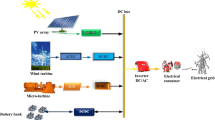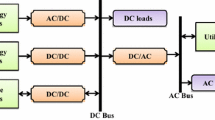Abstract
For the carbon-neutral, a multi-carrier renewable energy system (MRES), driven by the wind, solar and geothermal, was considered as an effective solution to mitigate CO2 emissions and reduce energy usage in the building sector. A proper sizing method was essential for achieving the desired 100% renewable energy system of resources. This paper presented a bi-objective optimization formulation for sizing the MRES using a constrained genetic algorithm (GA) coupled with the loss of power supply probability (LPSP) method to achieve the minimal cost of the system and the reliability of the system to the load real time requirement. An optimization App has been developed in MATLAB environment to offer a user-friendly interface and output the optimized design parameters when given the load demand. A case study of a swimming pool building was used to demonstrate the process of the proposed design method. Compared to the conventional distributed energy system, the MRES is feasible with a lower annual total cost (ATC). Additionally, the ATC decreases as the power supply reliability of the renewable system decreases. There is a decrease of 24% of the annual total cost when the power supply probability is equal to 8% compared to the baseline case with 0% power supply probability.
摘要
为了服务碳中和目标,由多种可再生能源组成的多能互补系统(MRES),例如风能、太阳能和地 热驱,被认为是减少建筑领域二氧化碳排放和节能的有效解决方案。容量优化设计方法是实现系统 100% 可再生能源利用的必要手段。本文针对MRES的容量设计构建了一种双目标优化方法,以系统 成本最低和系统供能实时可靠性为优化目标,利用带约束遗传算法(GA)结合供电可靠性(LPSP)方法作 为寻优算法。基于MATLAB 软件,开发了一个优化应用程序,给用户使用提供优化界面,在给定负 载需求时可以输出优化的设计参数。以一个游泳池建筑为案例来展示所提出优化设计方法的流程。与 传统的分布式能源系统相比,MRES 的年度总成本(ATC)较低,且ATC随着可再生能源系统的供电可 靠性的降低而降低。与LPSP 法为0%的基线情况相比,当供电可靠性值等于8%时,年度总成本下降24%。
Similar content being viewed by others
References
WIN T, MAKTIN H. Shell world energy model: A view to 2100 [R]. Shell International BV, 2017.
BENATIALLAH A, BENATIALLAH D, GHAITAOUI T, et al. Modelling and simulation of renewable energy systems in Algeria [J]. International Journal of Science and Applied Information Technology, 2017, 7(1): 17–22.
GHIANI E, PISANO G. Impact of renewable energy sources and energy storage technologies on the operation and planning of smart distribution networks [M]//Operation of Distributed Energy Resources in Smart Distribution Networks. Amsterdam: Elsevier, 2018: 25–48. DOI: https://doi.org/10.1016/b978-0-12-814891-4.00002-3.
EVANS A, STREZOV V, EVANS T J. Assessment of sustainability indicators for renewable energy technologies [J]. Renewable and Sustainable Energy Reviews, 2009, 13(5): 1082–1088. DOI: https://doi.org/10.1016/j.rser.2008.03.008.
BARBOSA L S, BOGDANOV D, VAINIKKA P, et al. Hydro, wind and solar power as a base for a 100% renewable energy supply for South and Central America [J]. PLoS One, 2017, 12(3): e0173820. DOI: https://doi.org/10.1371/journal.pone.0173820.
AGBOSSOU K, KOLHE M L, HAMELIN J, et al. Electrolytic hydrogen based renewable energy system with oxygen recovery and re-utilization [J]. Renewable Energy, 2004, 29(8): 1305–1318. DOI: https://doi.org/10.1016/j.renene.2003.12.006.
ISHAQ H, DINCER I. An efficient energy utilization of biomass energy-based system for renewable hydrogen production and storage [J]. Journal of Energy Resources Technology, 2022, 144(1): 011701. DOI: https://doi.org/10.1115/1.4050875.
LUO Zheng-yi, YANG Sheng, XIE Nan, et al. Multi-objective capacity optimization of a distributed energy system considering economy, environment and energy [J]. Energy Conversion and Management, 2019, 200: 112081. DOI: https://doi.org/10.1016/j.enconman.2019.112081.
CHEN Yu-fang, LIN Bo-qiang. Slow diffusion of renewable energy technologies in China: An empirical analysis from the perspective of innovation system [J]. Journal of Cleaner Production, 2020, 261: 121186. DOI: https://doi.org/10.1016/j.jclepro.2020.121186.
Renewable energy roadmap for China in 2030 [R]. Beijing, China: Energy Research Institute National Development and Reform Commission, 2011. (in Chinese)
LACKMANN T, HEWSON J C, KNAUS R C, et al. Stochastic modeling of unsteady extinction in turbulent non-premixed combustion [J]. Proceedings of the Combustion Institute, 2017, 36(2): 1677–1684. DOI: https://doi.org/10.1016/j.proci.2016.07.014.
ASCIONE F, BORRELLI M, de MASI R F, et al. Hourly operational assessment of HVAC systems in mediterranean nearly zero-energy buildings: Experimental evaluation of the potential of ground cooling of ventilation air [J]. Renewable Energy, 2020, 155: 950–968. DOI: https://doi.org/10.1016/j.renene.2020.03.180.
FENG Wei, ZHANG Qian-ning, JI Hui, et al. A review of net zero energy buildings in hot and humid climates: Experience learned from 34 case study buildings [J]. Renewable and Sustainable Energy Reviews, 2019, 114: 109303. DOI: https://doi.org/10.1016/j.rser.2019.109303.
CSOKNYAI T, LEGARDEUR J, AKLE A A, et al. Analysis of energy consumption profiles in residential buildings and impact assessment of a serious game on occupants’ behavior [J]. Energy and Buildings, 2019, 196: 1–20. DOI: https://doi.org/10.1016/j.enbuild.2019.05.009.
SUN Zhi-feng, ZHAO Yao-hua, XU Wei, et al. A solar heating and cooling system in a nearly zero-energy building: A case study in China [J]. International Journal of Photoenergy, 2017, 2017: 2053146. DOI: https://doi.org/10.1155/2017/2053146.
WU Wei, SKYE H M. Net-zero nation: HVAC and PV systems for residential net-zero energy buildings across the United States [J]. Energy Conversion and Management, 2018, 177: 605–628. DOI: https://doi.org/10.1016/j.enconman.2018.09.084.
GEIDL M. Integrated modeling and optimization of multi-carrier energy systems [D]. Switzerland: Swiss Federal Institute of Technology in Zurich, 2007: 1–3.
KIENZLE F, ANDERSSON G. A greenfield approach to the future supply of multiple energy carriers [C]//2009 IEEE Power & Energy Society General Meeting. Calgary, AB, Canada. IEEE: 1–8. DOI: https://doi.org/10.1109/PES.2009.5275692.1-8.
BIGLIA A, CAREDDA F V, FABRIZIO E, et al. Technical-economic feasibility of CHP systems in large hospitals through the energy Hub method: The case of Cagliari AOB [J]. Energy and Buildings, 2017, 147: 101–112. DOI: https://doi.org/10.1016/j.enbuild.2017.04.047.
MANCARELLA P. MES (multi-energy systems): An overview of concepts and evaluation models [J]. Energy, 2014, 65: 1–17. DOI: https://doi.org/10.1016/j.energy.2013.10.041.
MOHAMMADI-IVATLOO B, JABARI F. Operation, planning, and analysis of energy storage systems in smart energy hubs [M]. Cham: Springer International Publishing, 2018. DOI: https://doi.org/10.1007/978-3-319-75097-2.
MOHAMMADI M, NOOROLLAHI Y, MOHAMMADI-IVATLOO B, et al. Energy hub: From a model to a concept—A review [J]. Renewable and Sustainable Energy Reviews, 2017, 80: 1512–1527. DOI: https://doi.org/10.1016/j.rser.2017.07.030.
YANG Hong-xing, ZHOU Wei, LU Lin, et al. Optimal sizing method for stand-alone hybrid solar-wind system with LPSP technology by using genetic algorithm [J]. Solar Energy, 2008, 82(4): 354–367. DOI: https://doi.org/10.1016/j.solener.2007.08.005.
ERDINC O, UZUNOGLU M. Optimum design of hybrid renewable energy systems: Overview of different approaches [J]. Renewable and Sustainable Energy Reviews, 2012, 16(3): 1412–1425. DOI: https://doi.org/10.1016/j.rser.2011.11.011.
KOUTROULIS E, KOLOKOTSA D, POTIRAKIS A, et al. Methodology for optimal sizing of stand-alone photovoltaic/wind-generator systems using genetic algorithms [J]. Solar Energy, 2006, 80(9): 1072–1088. DOI: https://doi.org/10.1016/j.solener.2005.11.002.
YANG Hong-xing, ZHOU Wei, LOU Cheng-zhi. Optimal design and techno-economic analysis of a hybrid solar-wind power generation system [J]. Applied Energy, 2009, 86(2): 163–169. DOI: https://doi.org/10.1016/j.apenergy.2008.03.008.
DUFO-LÓPEZ R, BERNAL-AGUSTÍN J L. Multi-objective design of PV-wind-diesel-hydrogen-battery systems [J]. Renewable Energy, 2008, 33(12): 2559–2572. DOI: https://doi.org/10.1016/j.renene.2008.02.027.
MOHAMMADI M, HOSSEINIAN S H, GHAREHPETIAN G B. Optimization of hybrid solar energy sources/wind turbine systems integrated to utility grids as microgrid (MG) under pool/bilateral/hybrid electricity market using PSO [J]. Solar Energy, 2012, 86(1): 112–125. DOI: https://doi.org/10.1016/j.solener.2011.09.011.
KELLY G E, PARKEN W H Jr. Method of testing, rating and estimating the seasonal performance of central air conditioners and heat pumps operating in the cooling mode [R]. Washington, DC: Center for Building Technology, 1978. https://www.govinfo.gov/content/pkg/GOVPUB-C13-3506cbccbc0f9b4081bc7bc7c03d4657/pdf/GOVPUB-C13-3506cbccbc0f9b4081bc7bc7c03d4657.pdf.
SONG Han, DOTZAUER E, THORIN E, et al. Annual performance analysis and comparison of pellet production integrated with an existing combined heat and power plant [J]. Bioresource Technology, 2011, 102(10): 6317–6325. DOI: https://doi.org/10.1016/j.biortech.2011.02.042.
FABRIZIO E, FILIPPI M, VIRGONE J. An hourly modelling framework for the assessment of energy sources exploitation and energy converters selection and sizing in buildings [J]. Energy and Buildings, 2009, 41(10): 1037–1050. DOI: https://doi.org/10.1016/j.enbuild.2009.05.005.
BIGLARIAN H, ABBASPOUR M, SAIDI M H. Evaluation of a transient borehole heat exchanger model in dynamic simulation of a ground source heat pump system [J]. Energy, 2018, 147: 81–93. DOI: https://doi.org/10.1016/j.energy.2018.01.031.
VAEZ-ZADEH S, ISFAHANI A H. Multiobjective optimization of air-core linear permanent magnet synchronous motors for improved thrust and low magnet consumption [C]//International Conference on Electrical Machines and Systems. Nanjing, China: IEEE, 2005, 1: 226–229.
UMBARKAR A J, SHETH P D. Crossover operators in genetic algorithms: A review [J]. ICTACT Journal on Soft Computing, 2015, 6(1): 1083–1092. DOI: https://doi.org/10.21917/ijsc.2015.0150.
SAINI N. Review of selection methods in genetic algorithms [J]. International Journal of Engineering and Computer Science, 2017, 6: 23261–23263. DOI: https://doi.org/10.18535/ijecs6i12.04.
SONI N, KUMAR T. Study of Various mutation operators in genetic algorithms [J]. International Journal of Computer Science and Information Technologies (IJCSIT), 2014, 5: 4519–4521.
MA Teng-fei, WU Jun-yong, HAO Liang-liang, et al. The optimal structure planning and energy management strategies of smart multi energy systems [J]. Energy, 2018, 160: 122–141. DOI: https://doi.org/10.1016/j.energy.2018.06.198.
WU Qiong, ZHOU Jian, LIU Shu, et al. Multi-objective optimization of integrated renewable energy system considering economics and CO2 emissions [J]. Energy Procedia, 2016, 104: 15–20. DOI: https://doi.org/10.1016/j.egypro.2016.12.004.
EVINS R. Multi-level optimization of building design, energy system sizing and operation [J]. Energy, 2015, 90: 1775–1789. DOI: https://doi.org/10.1016/j.energy.2015.07.007.
ZHOU Zhe, LIU Pei, LI Zheng, et al. An engineering approach to the optimal design of distributed energy systems in China [J]. Applied Thermal Engineering, 2013, 53(2): 387–396. DOI: https://doi.org/10.1016/j.applthermaleng.2012.01.067.
AKHAVAN SHAMS S, AHMADI R. Dynamic optimization of solar-wind hybrid system connected to electrical battery or hydrogen as an energy storage system [J]. International Journal of Energy Research, 2021, 45(7): 10630–10654. DOI: https://doi.org/10.1002/er.6549.
ZHANG Jing-jing, ZHOU Nan, HINGE A, et al. Governance strategies to achieve zero-energy buildings in China [J]. Building Research & Information, 2016, 44(5–6): 604–618. DOI: https://doi.org/10.1080/09613218.2016.1157345.
SATOLA D, KRISTIANSEN A B, HOULIHAN-WIBERG A, et al. Comparative life cycle assessment of various energy efficiency designs of a container-based housing unit in China: A case study [J]. Building and Environment, 2020, 186: 107358. DOI: https://doi.org/10.1016/j.buildenv.2020.107358.
DOHERTY B, TRENBATH K. Device-level plug load disaggregation in a zero energy office building and opportunities for energy savings [J]. Energy and Buildings, 2019, 204: 109480. DOI: https://doi.org/10.1016/j.enbuild.2019.109480.
Author information
Authors and Affiliations
Contributions
SOULEY AGBODJAN Yawovi conducted the literature review, modeling and wrote the first draft of the manuscript. LIU Zhi-qiang provided the concept and revised the final version. WANG Jia-qiang provided the conceptualization, methodology and analyzed the measured data. YUE Chang revised the original draft and edited the draft of the manuscript. LUO Zheng-yi provided some models and edited the draft of the manuscript. All authors replied to reviewers’ comments and revised the final version.
Corresponding authors
Additional information
Conflict of interest
The authors declare that they have no known competing financial interests or personal relationships that could have appeared to influence the work reported in this paper.
Foundation item: Project(52108101) supported by the National Natural Science Foundation of China; Projects(2020GK4057, 2021JJ40759) supported by the Hunan Provincial Science and Technology Department, China
Rights and permissions
About this article
Cite this article
Souley Agbodjan, Y., Liu, Zq., Wang, Jq. et al. Modeling and optimization of a multi-carrier renewable energy system for zero-energy consumption buildings. J. Cent. South Univ. 29, 2330–2345 (2022). https://doi.org/10.1007/s11771-022-5107-5
Received:
Accepted:
Published:
Issue Date:
DOI: https://doi.org/10.1007/s11771-022-5107-5
Key words
- multi-carrier renewable energy system
- constrained genetic algorithm
- loss of power supply probability (LPSP) method
- zero-energy consumption building
- optimal device capacity




